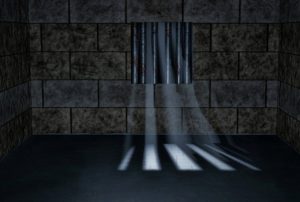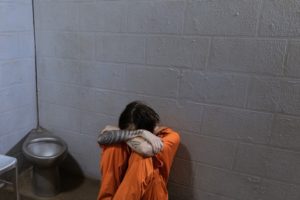The Hole: The History and Dangers of Solitary Confinement
By Mafatou J. – Criminal Justice Intern
 The very first official experiment of solitary confinement in the United States was conducted by Dr. Benjamin Rush in 1829, at the Southeastern Pennsylvania Penitentiary in Philadelphia. Solitary confinement involved holding an inmate for 23 hours a day in a cell that had a steel door with no visibility of the other side, and the only objects in the room consisted of a bed, toilet, and sink. The inmates were served meals through a tiny slot in the door and they did not interact with guards unless they were being escorted to the showers, the infirmary, or legal proceedings. The inmates had no interaction with other prisoners and had very limited and secluded yard time. Dr. Rush and his colleagues believed complete isolation would lead prisoners to reflection and eventually penitence. However, the experiment just exposed the dangerous effects total isolation could have on the human psyche when most of the participants committed suicide. Regardless of the results, the U.S. government kept conducting these experiments and eventually instilled this method of punishment into most prisons.
The very first official experiment of solitary confinement in the United States was conducted by Dr. Benjamin Rush in 1829, at the Southeastern Pennsylvania Penitentiary in Philadelphia. Solitary confinement involved holding an inmate for 23 hours a day in a cell that had a steel door with no visibility of the other side, and the only objects in the room consisted of a bed, toilet, and sink. The inmates were served meals through a tiny slot in the door and they did not interact with guards unless they were being escorted to the showers, the infirmary, or legal proceedings. The inmates had no interaction with other prisoners and had very limited and secluded yard time. Dr. Rush and his colleagues believed complete isolation would lead prisoners to reflection and eventually penitence. However, the experiment just exposed the dangerous effects total isolation could have on the human psyche when most of the participants committed suicide. Regardless of the results, the U.S. government kept conducting these experiments and eventually instilled this method of punishment into most prisons.
Solitary confinement began to be seriously practiced in the U.S. when the government built Alcatraz Federal Prison in 1934 in an effort to house the nation’s most ruthless criminals. In Alcatraz, there was a section of the prison known as D Block that was dedicated entirely to solitary confinement but there was an even more specialized area of D Block known as “the Hole” where the real horrors occurred. There, inmates were stripped naked and held in rooms made entirely of concrete. Scraps of food were shoved through a small hole in the door and they were forced to use another hole in the floor as a toilet. The goal was not just to restrict inmates and confiscate their access to other individuals but to punish and completely humiliate them. Although Alcatraz was closed just 29 years later, a modernized version of solitary confinement began to be inserted into U.S. prisons in the 1960s when the government not only built special wings in current prisons to model the D Block unit of Alcatraz but new supermax prisons where the entire facility was dedicated to solitary confinement were developed as well. Since then the practice has carried the nickname “The Hole”.
 Disturbingly, modern solitary confinement does not differ much from the days of Dr. Rush’s study. In modern prisons, solitary confinement still holds some prisoners for 23 to 24 hours a day, especially in supermax prisons. Prisoners can be in solitary confinement for weeks, months, or even years at a time. Today, there are many reasons an inmate can be banished to the Hole such as the seriousness of the crime they are convicted of, fighting among prisoners, attacking guards, breaking other prison rules, or for the prisoner’s own safety. However, research has shown that this method is more harmful than beneficial in a number of ways. Multiple studies since the one conducted in Philadelphia have shown that solitary confinement is a barbaric and torturous method of punishment that can be worse than physical pain. It leaves individuals with no stimulation other than their minds and their complete imagination. There is no indication of time or outside life which can lead to inmates feeling forgotten and forces them to question their very existence. Most confined individuals develop anxiety, depression, become deranged, resort to self-harm, and even suicide. Most inmates also suffer long-lasting effects that can mirror PTSD and continue beyond the inmate’s release from prison. One study in New York showed that solitary confinement accounted for only 7% of inmates but was responsible for over 50% of injuries in the prison. In addition to the negative effects on the mind, solitary confinement is sometimes used by guards to target and humiliate certain individuals based on personal biases. Black inmates are much more likely to end up in solitary confinement and so are inmates who identify as members of the LGBTQ community. Housing an inmate in solitary confinement also costs three times more than housing them in a regular cell, not to mention the negative effects it has on recidivism rates. Regardless of the research against it, nearly 20% of prisoners and 18% of inmates in jail have spent some time in solitary confinement.
Disturbingly, modern solitary confinement does not differ much from the days of Dr. Rush’s study. In modern prisons, solitary confinement still holds some prisoners for 23 to 24 hours a day, especially in supermax prisons. Prisoners can be in solitary confinement for weeks, months, or even years at a time. Today, there are many reasons an inmate can be banished to the Hole such as the seriousness of the crime they are convicted of, fighting among prisoners, attacking guards, breaking other prison rules, or for the prisoner’s own safety. However, research has shown that this method is more harmful than beneficial in a number of ways. Multiple studies since the one conducted in Philadelphia have shown that solitary confinement is a barbaric and torturous method of punishment that can be worse than physical pain. It leaves individuals with no stimulation other than their minds and their complete imagination. There is no indication of time or outside life which can lead to inmates feeling forgotten and forces them to question their very existence. Most confined individuals develop anxiety, depression, become deranged, resort to self-harm, and even suicide. Most inmates also suffer long-lasting effects that can mirror PTSD and continue beyond the inmate’s release from prison. One study in New York showed that solitary confinement accounted for only 7% of inmates but was responsible for over 50% of injuries in the prison. In addition to the negative effects on the mind, solitary confinement is sometimes used by guards to target and humiliate certain individuals based on personal biases. Black inmates are much more likely to end up in solitary confinement and so are inmates who identify as members of the LGBTQ community. Housing an inmate in solitary confinement also costs three times more than housing them in a regular cell, not to mention the negative effects it has on recidivism rates. Regardless of the research against it, nearly 20% of prisoners and 18% of inmates in jail have spent some time in solitary confinement.
The practices inflicted on prisoners that are received with complete indifference by the public would send the nation into an uproar if inflicted on other citizens. Humans are social creatures by nature which means complete isolation, in stale surroundings, in addition to the lack of stimulation and basic acknowledgment could cause even the most stable individual to experience a psychotic episode. However, the stigma around incarcerated individuals leaves the public with such a negative view that we tend to overlook prisoners and conveniently forget that they are human beings who made mistakes. The suffering of prisoners is not acknowledged and sometimes it’s even celebrated. Logically we know we cannot lock people up, throw away the key, all while claiming it’s a form of rehabilitation when the research shows it accomplishes the complete opposite. If everything about experiments such as Alcatraz and Dr. Rush’s study was a failure then it seems to follow the definition of insanity to take a piece of those experiments and establish it all over the country. If the goal of U.S. prisons is to truly reform, then citizens must force the U.S. Government to reevaluate the use of the “Hole” and determine if it still has a place in a modern, evolved society.